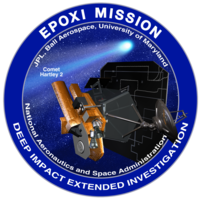 The Deep Impact spacecraft at Ball Aerospace & Technologies in July 2004. | |
| Mission type |
|
|---|---|
| Operator | NASA |
| COSPAR ID | 2005-001A |
| Website | epoxi |
| Mission duration | 8 years, 18 days |
| Spacecraft properties | |
| Spacecraft | Deep Impact |
| Manufacturer | JPL · Ball Aerospace · University of Maryland |
| Launch mass | 650 kg[1] |
| Power | 620.0 W |
| Start of mission | |
| Entered service | July 21, 2005 (19 years, 4 months and 5 days ago) |
| End of mission | |
| Last contact | August 8, 2013 (11 years, 3 months and 18 days ago) |
| Flyby of Hartley 2 | |
| Closest approach | November 4, 2010 ~03:00 UTC (14 years and 22 days ago) |
| Distance | 694 kilometres (431 mi) |
 Official insignia for the re-targeted DIXI mission to Hartley 2 | |
EPOXI was a compilation of NASA Discovery program missions led by the University of Maryland and principal investigator Michael A'Hearn, with co-operation from the Jet Propulsion Laboratory and Ball Aerospace. EPOXI uses the Deep Impact spacecraft in a campaign consisting of two missions: the Deep Impact Extended Investigation (DIXI) and Extrasolar Planet Observation and Characterization (EPOCh). DIXI aimed to send the Deep Impact spacecraft on a flyby of another comet, after its primary mission was completed in July 2005, while EPOCh saw the spacecraft's photographic instruments as a space observatory, studying extrasolar planets.[2][3][4]
DIXI successfully sent the Deep Impact spacecraft on a flyby of comet Hartley 2 on November 4, 2010, revealing a "hyperactive, small and feisty" comet, after three gravity assists from Earth in December 2007, December 2008 and June 2010. The DIXI mission was not without problems, however; the spacecraft had initially been targeted for a December 5, 2008 flyby of comet Boethin, though, the comet could not be located, and was later declared a lost comet, prompting mission planners to reorganize a flyby of an alternative target, Hartley 2. After its flyby of Hartley 2, the spacecraft was also set to make a close flyby of the Apollo asteroid (163249) 2002 GT in 2020. The mission was suspended altogether, however, after contact with the spacecraft was suddenly lost in August 2013 and attempts to re-establish contact in the month following had failed.[5] Mission scientists theorized that a Y2K-like problem had plagued the spacecraft's software.
- ^ "EPOXI". NASA's Solar System Exploration website. Retrieved November 30, 2022.
- ^ "NASA Gives Two Successful Spacecraft New Assignments" (Press release). NASA. July 3, 2007. Archived from the original on 17 April 2011. Retrieved 7 August 2009.
- ^ "NASA Sends Spacecraft on Mission to Comet Hartley 2" (Press release). NASA. Dec 13, 2007. Archived from the original on 3 August 2009. Retrieved 7 August 2009.
- ^ "Deep Impact Extended Mission Heads for Comet Hartley 2" (Press release). University of Maryland. December 13, 2007. Archived from the original on 20 June 2009. Retrieved 7 August 2009.
- ^ NASA calls off search for lost Deep Impact comet probe - Australian Broadcasting Corporation - Retrieved September 21, 2013.